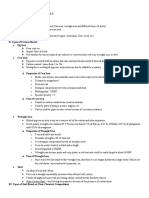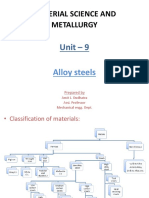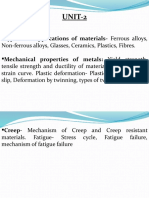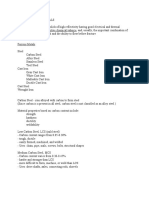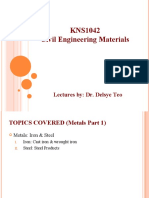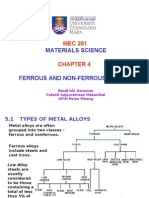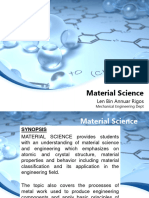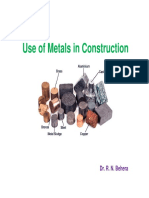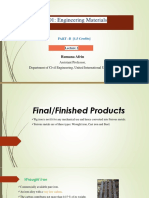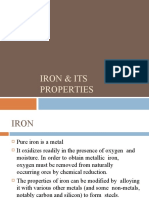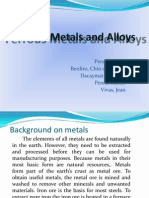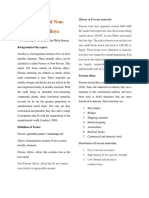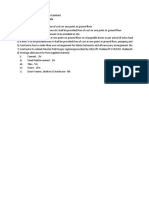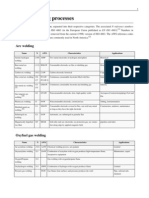Ferrous Metals(Alloys) :
Ferrous metals are alloys or metals contain iron, and are known
for their strength. Steel, stainless steel, carbon steel, cast iron.
Types of Ferrous Metals – Classification Based on Composition
Ferrous Metals
Pig Iron
Wrought Iron
Cast Iron
Gray cast iron White cast iron Malleable cast iron Ductile cast iron
Steel
Low-carbon steel Medium-Carbon Steel High-Carbon Steel
Stainless Steel
Super alloys
Special Ferrous Metals
Tool Steels
High-speed Steels
Shock-resisting Steels
Silver Steel
1
� Pig Iron (Iron Ore). In general, the pig iron is an intermediate product of the iron
industry. Pig iron, known also as crude iron, is produced by the blast furnace
process and contains up to 4–5% carbon, with small amounts of other impurities
like sulfur, magnesium, phosphorus, and manganese. The high level of carbon
makes it relatively weak and brittle. Reducing the amount of carbon to 0.002–
2.1% by mass produces steel, which may be up to 1000 times harder than pure
iron.
Wrought Iron. Wrought iron is an iron alloy with very low carbon content (less
than 0.08%). The microstructure of wrought iron shows dark slag inclusions in
ferrite. It is soft, ductile, magnetic, corrosion-resistant and easily welded. It has
high elasticity and tensile strength. It can be heated and reheated and worked
into various shapes. Wrought iron is no longer produced on a commercial scale.
Many products described as wrought iron, such as guard rails, garden furniture
and gates, are actually made of mild steel. For example, the Eiffel Tower is a
wrought-iron lattice tower.
Uses: Wrought iron is used for porch railings, fencing, farm implements,
nails, barbed wire, chains, modern household furniture, ornaments and
decorations.
Capabilities: Wrought iron can be gas and arc welded, machined, plated,
and is easily formed.
Advantages: Wrought iron is bends easily when cold or when heated. It is
easy to weld and rusts slowly.
Limitations: Wrought iron has low hardness and low fatigue strength.
Properties: Wrought iron has Brinell hardness number of 105; tensile
strength of 35,000 psi; specific gravity of 7.7; melting point of 2750°F
(1510°C); and is ductile and corrosion-resistant.
Cast Iron (Gray, White And Malleable)
Cast iron is a man-made alloy of iron, carbon, and silicon. A portion of the carbon
exists as free carbon or graphite. Total carbon content is between 1.7 and 4.5
percent.
Uses: Cast iron is used for water pipes, machine tool castings,
transmission housing, engine blocks, pistons, stove castings, etc.
Capabilities: Cast iron may be brazed or bronze welded, gas and arc
welded, hardened, or machined.
Limitations: Cast iron must be preheated prior to welding. It cannot be
worked cold.
2
� Properties:
Cast iron has a Brinell hardness number of 150 to 220 (no alloys) and
300 to 600 (alloyed)
Tensile strength of 25,000 to 50,000 psi (172,375 to 344,750 kPa) (no
alloys) and 50,000 to 100,000 psi (344,750 to 689,500 kPa) (alloyed)
Specific gravity of 7.6
High compressive strength that is four times its tensile strength
High rigidity
Good wear resistance
Fair corrosion resistance.
Gray cast iron. Grey cast iron is the oldest and most common type of cast
iron. Grey cast iron is characterised by its graphitic microstructure, which
causes fractures of the material to have a grey appearance.
White cast iron. White cast irons are hard, brittle, and unmachinable, while
gray irons with softer graphite are reasonably strong and machinable. A
fracture surface of this alloy has a white appearance, and thus it is termed
white cast iron.
Malleable cast iron. Malleable cast iron is white cast iron that has been
annealed. Through an annealing heat treatment, the brittle structure as first
cast is transformed into the malleable form.
Ductile cast iron. Ductile iron, also known as nodular iron, is very similar to
gray iron in composition, ductile iron is stronger and more shock resistant
than gray iron. In fact, ductile iron has mechanical characteristics approaching
those of steel, while it retains high fluidity when molten and lower melting
point.
Steel
A form of iron, steel is one of the ferrous metals that contain less carbon than
cast iron, but considerably more than wrought iron. The carbon content is from
0.03 to 1.7 percent. Basic carbon steels are alloyed with other elements, such as
chromium and nickel, to increase certain physical properties of the metal.
Uses: Steel is used to make nails, rivets, gears, structural steel, desks,
hoods, fenders, chisels, hammers, etc.
Capabilities: Steel can be machined, welded, and forged, all to varying
degrees, depending on the type of steel.
Limitations: Highly alloyed steel is difficult to produce.
Properties: Steel has tensile strength of 45,000 psi (310,275 kPa) for low-
carbon steel, 80,000 psi (551,600 kPa) for medium-carbon steel, 99,000
psi (692,605 kPa) for high-carbon steel, and 150,000 psi (1,034,250 kPa)
for alloyed steel; and a melting point of 2800° F (1538°C).
3
� Low-carbon steel (carbon content up to 0.30 percent.
This steel is soft and ductile, and can be rolled, punched, sheared, and worked
when either hot or cold. It is easily machined and can readily be welded by all
methods. It does not harden to any great amount; however, it can easily be case
hardened.
Medium-Carbon Steel (Carbon Content Ranging From
.30% To .50%)
This steel may be heat-treated after fabrication. It is used for general machining
and forging of parts that require surface hardness and strength. It is made in bar
form in the cold-rolled or the normalized and annealed condition. During welding,
the weld zone will become hardened if cooled rapidly and must be stress-relieved
after welding.
High-Carbon Steel (Carbon Content Ranging From .50%
To .90%)
This steel is used for the manufacture of drills, taps, dies, springs, and other
machine tools and hand tools that are heat-treated after fabrication to develop
the hard structure necessary to withstand high shear stress and wear.
It is manufactured in bar, sheet, and wire forms, and in the annealed or
normalized condition in order to be suitable for machining before heat treatment.
This steel is difficult to weld because of the hardening effect of heat at the welded
joint.
4
� Stainless Steels
Stainless steels contain several alloying elements that are in line with
the specific composition and grade. The following sections describe
the alloying additions and the reasons they are present,
1. Carbon: Carbon and iron are alloyed together to form steel. This
process boosts the strength and hardness of iron. Heat treatment is not
adequate to strengthen and harden pure iron, but when carbon is added,
a wide range of strength and hardness is realized.
High carbon content is not preferred in Ferritic and Austenitic stainless
steels, specifically for welding purposes, due to the risk of carbide
precipitation.
2. Manganese: The addition of manganese to steel improves hot working
properties and boosts toughness, strength, and hardenability. Just like
nickel, manganese is an Austenite forming element and has been
traditionally used as a replacement for nickel in the AISI200 range of
Austenitic stainless steels, for example AISI 202 as a replacement for
AISI 304.
3. Nitrogen: Similar to nickel, nitrogen is an Austenite forming element and
increases the Austenite stability of stainless steels. When nitrogen is
mixed with stainless steels, yield strength is considerably enhanced
along with increased resistance to pitting corrosion.
4. Copper: In stainless steel, copper is often present as a residual
element. This element is added to several alloys to create precipitation
hardening characteristics or to improve corrosion resistance,
predominantly in sulphuric acid and sea water conditions.
5. Nickel: It may be termed as one of the most important alloying
elements. It improves tensile strength, ductility, toughness and corrosion
resistance.
6. Chromium: Its addition to steel improves toughness, hardness and
corrosion resistance.
7. Boron: It increases hardenability and is therefore very useful when
alloyed with low carbon steels.
5
�8. Cobalt: It is added to high speed steels to improve hardness,
toughness, tensile strength, thermal resistance and magnetic properties.
It acts as a grain purifier.
9. Tungsten: Tungsten improves hardness, toughness, wear resistance,
shock resistance, magnetic reluctance and ability to retain hardness at
elevated temperatures. It provides hardness and abrasion resistance
properties to steel.
10. Molybdenum: It improves wear resistance, hardness, thermal
resistance, ability to retain mechanical properties at elevated
temperatures and helps to inhibit temper brittleness.
11. Vanadium: It increases tensile strength, elastic limit, ductility, shock
resistance and also acts as a degaser when added to molten steel. It
provides improvement to hardenability of steel.
It is a very good deoxidizer and promotes grain growth. It is the
strongest carbide former. Titanium is used to fix carbon in stainless steel
and thus prevents the precipitation of chromium-carbide.
12. Niobium: It improves ductility, decreases hardenability and substantially
improves the impact strength. It also promotes fine grain growth.
13. Calcium: Calcium is added in small amounts to enhance machiniability,
without having any detrimental effect on other properties induced by
selenium, phosphorus and. sulphur.
14. SiIicon: Silicon is typically employed as a deoxidizing (killing) agent in
the steel melting process, and a small amount of silicon is used in most
steels.
15. Phosphorus : In order to improve machinability, phosphorus is often
added with sulphur. While the presence of phosphorus in Austenitic
stainless steels boosts strength, it has a detrimental effect on corrosion
resistance and increases the material’s tendency to break during
welding.
16. Sulphur: Sulphur improves machinability when it is added in small
quantities, but just like phosphorous, it has a negative effect on
corrosion resistance and the subsequent weldability.
17. Selenium:Selenium was previously employed as an addition to enhance
machinability.
6
�The Families Of Stainless Steels
Stainless steels are iron-based alloys containing a minimum of about 10.5% chromium;
this forms a protective self-healing oxide film, which is the reason why this group of
steels has their characteristic "stainlessness" or corrosion resistance. The ability of the
oxide layer to heal itself means that the steel is corrosion resistant, no matter how much
of the surface is removed. This is not the case when carbon or low alloy steels are
protected from corrosion by metallic coatings such as zinc or cadmium or by organic
coatings such as paint.
Figure 1. Families of stainless steels.
Austenitic Stainless Steels
This group contains at least 16% chromium and 6% nickel (the basic grade 304 is
referred to as 18/8) and range through to the high alloy or "super austenitics" such as
904L and 6% molybdenum grades.
The relationship between the various austenitic grades is shown in Figures 2.
7
� Figure 2. The Austenitic Stainless Steels
Ferritic Stainless Steels
These are plain chromium (10.5 to 18%) grades such as Grade 430 and 409. Their
moderate corrosion resistance and poor fabrication properties are improved in the
higher alloyed grades such as Grades 434 and 444 and in the proprietary grade
3CR12.
The relationship between the various ferritic grades is shown in Figure 3.
Figure 3. Families of ferritic stainless steels.
8
�Martensitic Stainless Steels
Martensitic stainless steels are also based on the addition of chromium as the major
alloying element but with a higher carbon and generally lower chromium content (e.g.
12% in Grade 410 and 416) than the ferritic types; Grade 431 has a chromium content
of about 16%, but the microstructure is still martensite despite this high chromium level
because this grade also contains 2% nickel.
The relationship between the various martensitic grades is shown in Figure 4.
Figure 4. The families of martensitic stainless steels.
Duplex Stainless Steels
Duplex stainless steels such as 2304 and 2205 (these designations indicate
compositions of 23% chromium, 4% nickel and 22% chromium, 5% nickel but both
grades contain further minor alloying additions) have microstructures comprising a
mixture of austenite and ferrite. Duplex ferritic - austenitic steels combine some of the
features of each class: they are resistant to stress corrosion cracking, albeit not quite as
resistant as the ferritic steels; their toughness is superior to that of the ferritic steels but
inferior to that of the austenitic steels, and their strength is greater than that of the
(annealed) austenitic steels, by a factor of about two. In addition the duplex steels have
general corrosion resistances equal to or better than 304 and 316, and in general their
pitting corrosion resistances are superior to 316. They suffer reduced toughness below
about –50°C and after exposure above 300°C, so are only used between these
temperatures.
9
�The relationship between the various duplex grades is shown in Figures 5.
Figure 5. The families of duplex stainless steels.
Precipitation Hardening Stainless Steels
These are chromium and nickel containing steels that can develop very high tensile
strengths. The most common grade in this group is "17-4 PH", also known as Grade
630, with the composition of 17% chromium, 4% nickel, 4% copper and 0.3% niobium.
The great advantage of these steels is that they can be supplied in the "solution treated"
condition. In this condition the steel is just machineable. Following machining, forming
etc. the steel can be hardened by a single, fairly low temperature "ageing" heat
treatment which causes no distortion of the component.
Characteristics Of Stainless Steels
The characteristics of the broad group of stainless steels can be viewed as compared to
the more familiar plain carbon "mild" steels. As a generalisation the stainless steels
have:
• Higher work hardening rate
• Higher ductility
• Higher strength and hardness
• Higher hot strength
• Higher corrosion resistance
• Higher cryogenic toughness
• Lower magnetic response (austenitic only)
• Must retain corrosion resistant surface in the finished product.
10
� Super alloys
Superalloys are a group of nickel, iron–nickel and cobalt alloys used in
jet engines. These metals have excellent heat resistant properties and
retain their stiffness, strength, toughness and dimensional stability at
temperatures much higher than the other aerospace structural materials.
In what applications are Superalloys used?
Aerospace
Turbine blades and jet/rocket engines
Marine industry
Submarines
Chemical processing industry
Nuclear reactors
Heat exchanger tubing
Industrial gas turbines
What are the characteristics of Superalloys?
Excellent mechanical strength and creep resistance at high
temperatures
Good surface stability
Corrosion and oxidation resistant
11














